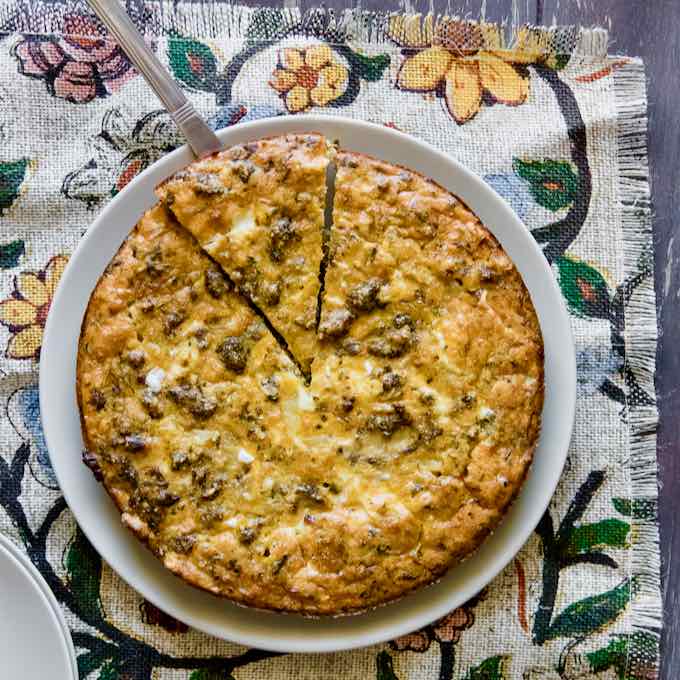Tunisian Tajine: Not the Stew You Think It Is
When most people hear “tajine,” they picture a Moroccan clay pot stew simmering for hours. But in Tunisia, Tajine (Tajine Tounsi) is something completely different. Here, it’s a baked egg dish — closer to a frittata or crustless quiche — filled with meat, cheese, herbs, and potatoes. It’s cut into squares or wedges and served warm or cold, making it one of the most versatile staples of Tunisian cuisine.
We first tried Tajine in Monastir at a small family-run restaurant. A golden, slightly crisp top gave way to a tender, savory filling of chicken, potato, and parsley. It felt both hearty and light, and it was served with nothing more than a squeeze of lemon and some crusty bread. Simple, satisfying, and unmistakably Tunisian.
Tunisian Tajine is a celebration dish as much as it is everyday food. It’s a must on the table during Ramadan, often prepared ahead of time so families can break the fast with it. But you’ll also find it at weddings, picnics, or as part of a mezze spread. Every household has its own version — some use chicken, others lamb, tuna, or merguez sausage. Cheese, parsley, and spices like cumin and turmeric give it its characteristic flavor.

What’s the difference between Tunisian and Moroccan Tajine?
In Morocco, a tajine is a slow-cooked stew made in a clay pot of the same name. In Tunisia, a tajine is a baked egg dish, more like a frittata. They share a name but are completely different dishes.
What is Tunisian Tajine made of?
The base is eggs, cheese, and breadcrumbs. To this, Tunisians add diced meat (chicken, lamb, or tuna), potatoes, parsley, and spices like cumin and turmeric. It’s baked until firm, then cut into slices or squares.
Is Tunisian Tajine eaten hot or cold?
Both! It’s delicious warm out of the oven, but just as good at room temperature. That’s why it’s perfect for picnics and family gatherings.
Is Tunisian Tajine healthy?
Yes. With eggs, lean meat, parsley, and spices, Tajine is high in protein and nutrients. While it contains cheese and breadcrumbs, it’s much lighter than many baked dishes and can easily be adapted with vegetables for a healthier version.
Can you make Tunisian Tajine vegetarian?
Absolutely. Skip the meat and add spinach, zucchini, or even mushrooms. The egg and cheese base makes it flexible for endless variations.
When do Tunisians eat Tajine?
Tajine is especially popular during Ramadan, when it’s served as part of iftar (the meal to break the fast). But it’s also found at weddings, holidays, and as a snack or light lunch year-round.
Share this recipe
Tajine (Baked Egg & Meat Casserole)

NUTRITION
Ingredients
- 300 g chicken breast or lamb cooked and diced
- 1 medium onion finely chopped
- 3 tbsp olive oil
- 5 large eggs
- 1 medium potato boiled and diced
- ½ cup grated cheese Gruyère, Parmesan, or local cheese
- 2 tbsp chopped parsley
- 1 tsp ground turmeric
- 1 tsp ground cumin
- ½ tsp cinnamon optional
- Salt and pepper to taste
- 2 tbsp breadcrumbs plus extra for dusting the baking dish
Instructions
- Prepare the meat: Heat olive oil in a pan and sauté the onion until soft. Add the diced cooked chicken or lamb, season with turmeric, cumin, cinnamon (if using), salt, and pepper. Cook for 5–7 minutes, then set aside.
- Mix the base: In a large bowl, beat the eggs. Stir in the diced potato, grated cheese, parsley, breadcrumbs, and the cooked meat mixture. Combine well.
- Prepare the dish: Grease a baking dish with olive oil and dust lightly with breadcrumbs to prevent sticking.
- Bake: Pour in the mixture, smooth the top, and bake in a preheated oven at 180°C (350°F) for 25–30 minutes, until firm and golden on top.
- Serve: Let cool slightly before slicing into squares or wedges. Serve warm or at room temperature.

